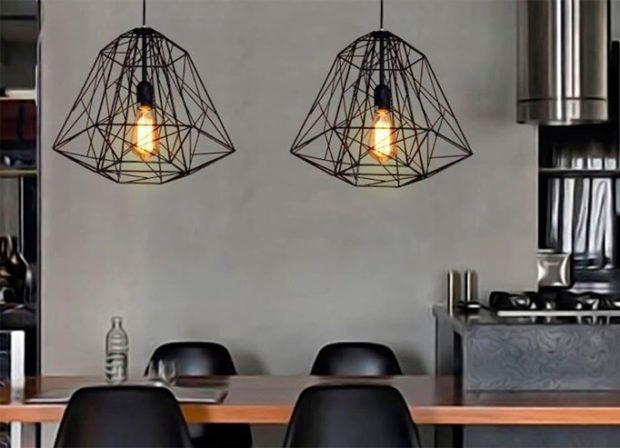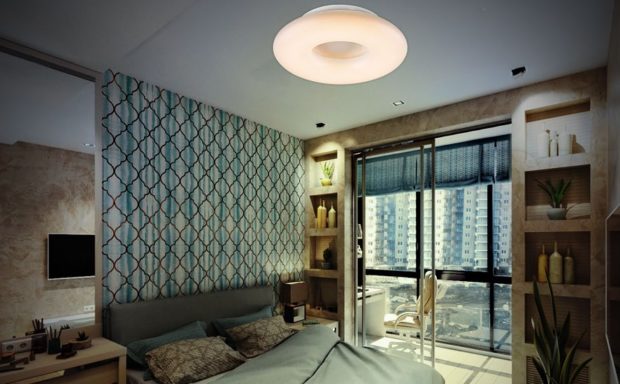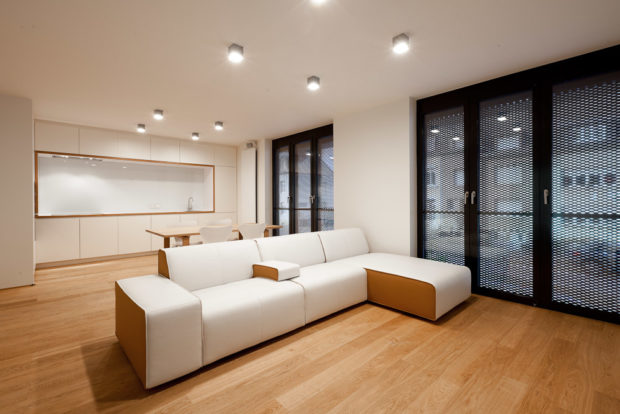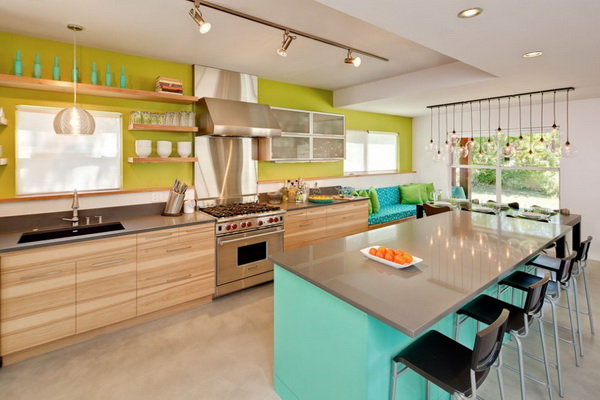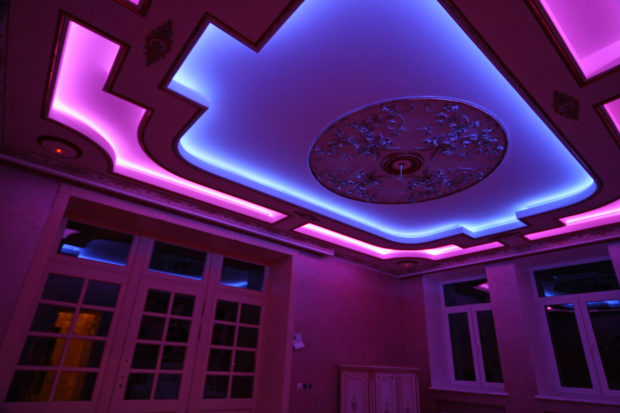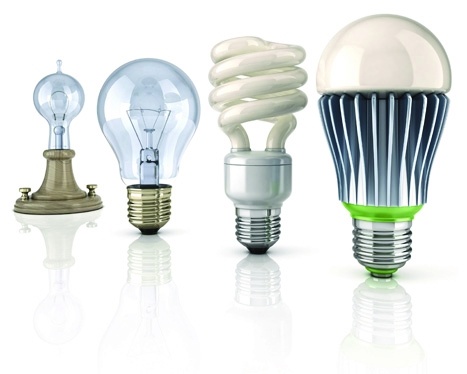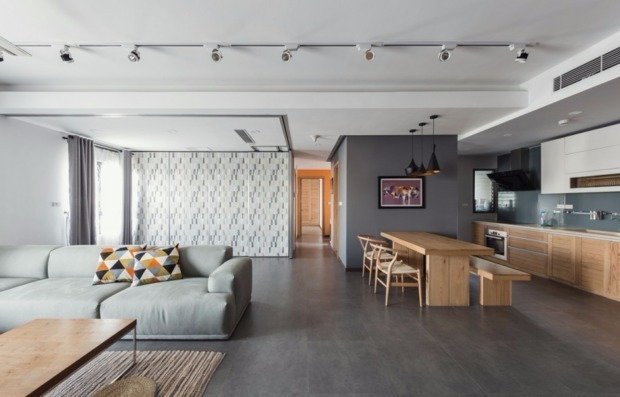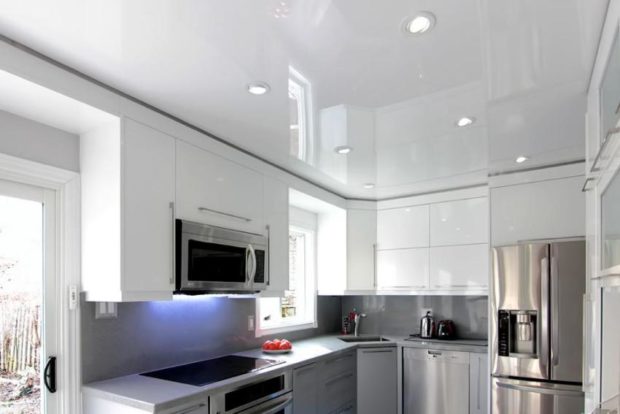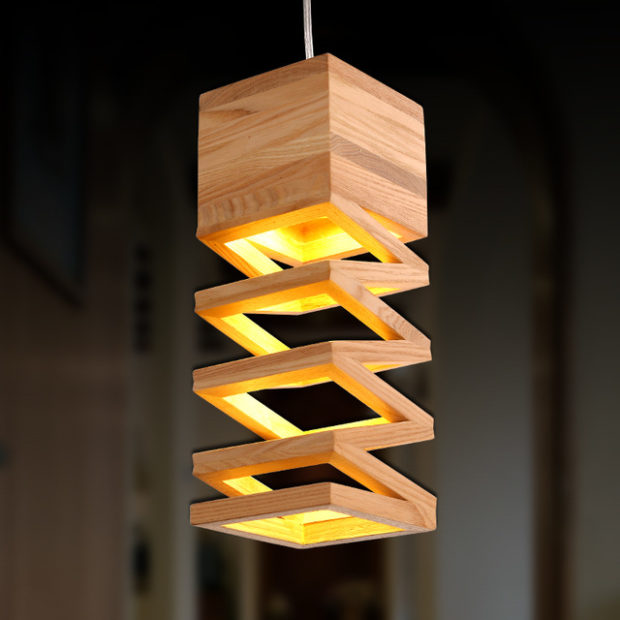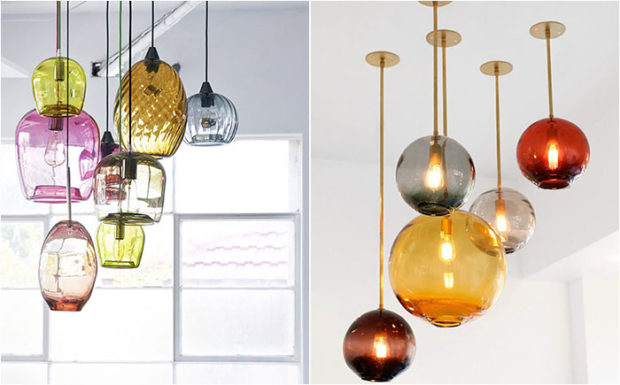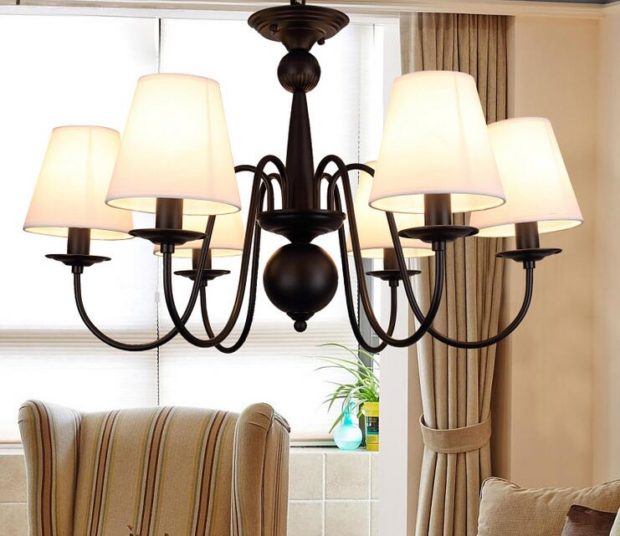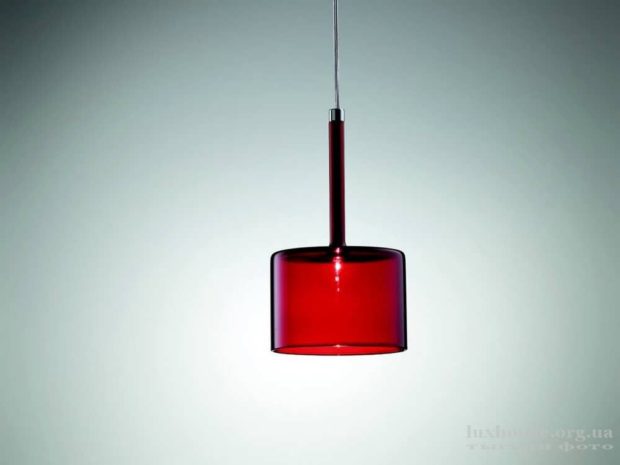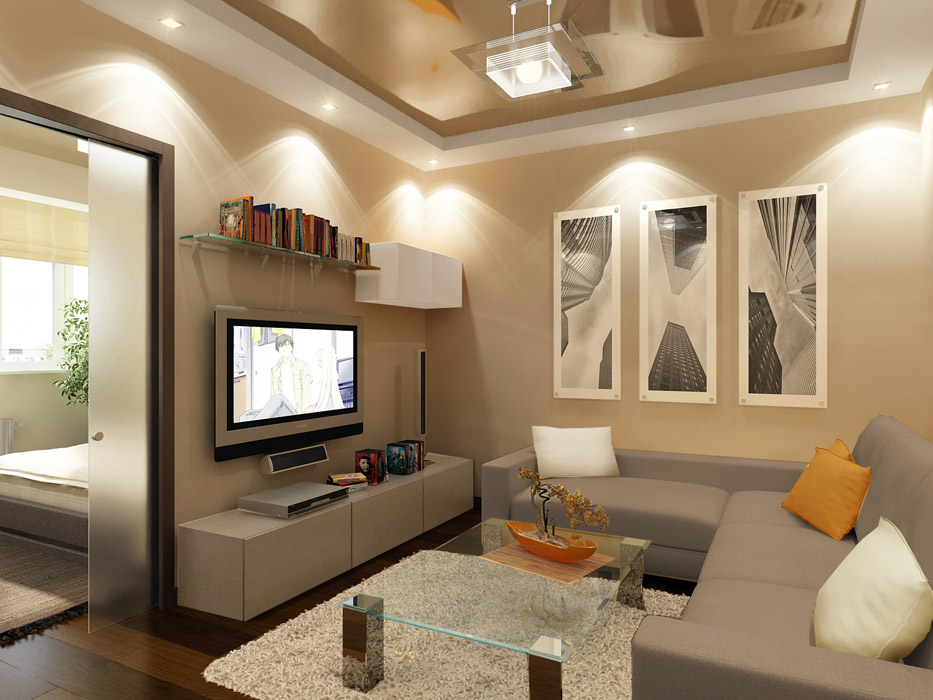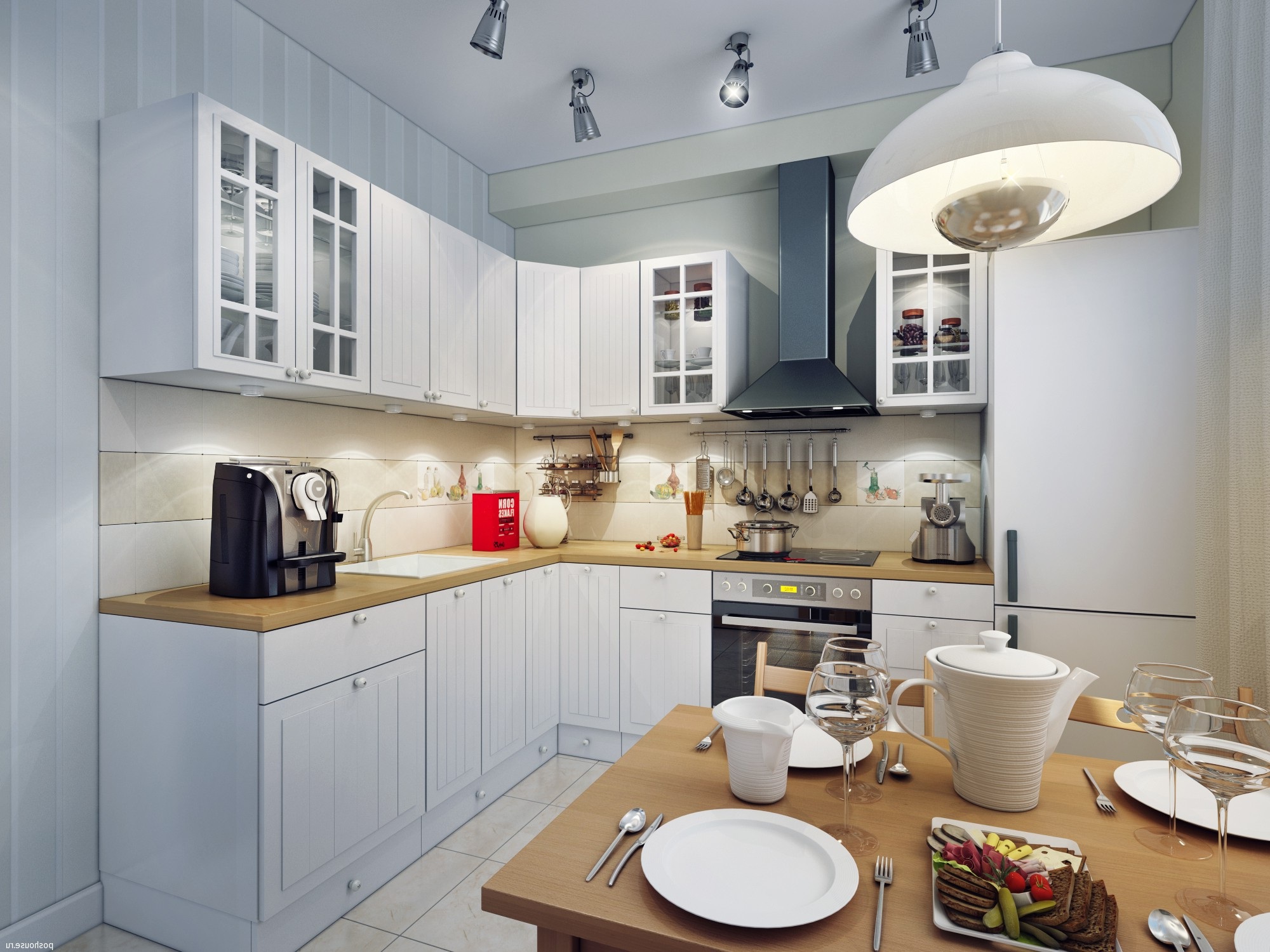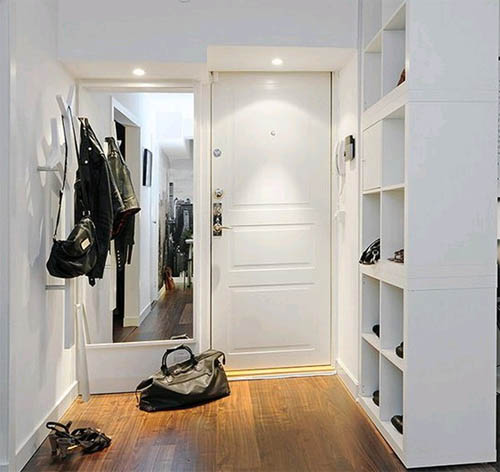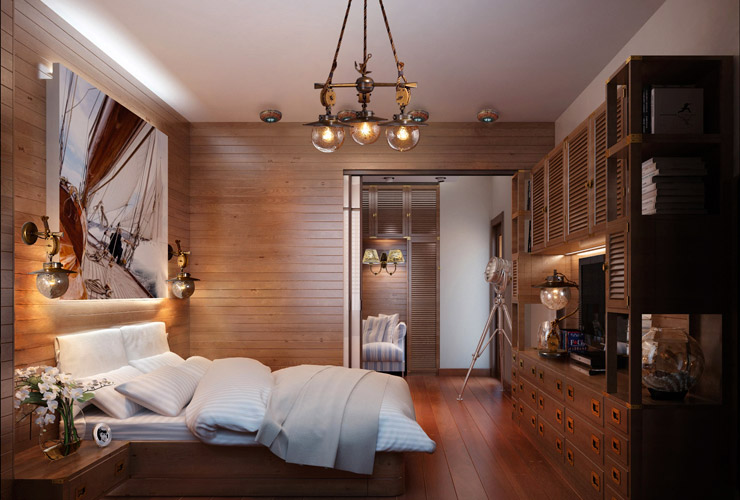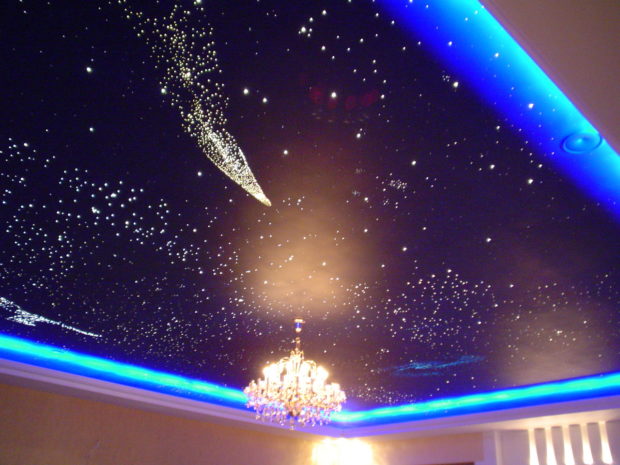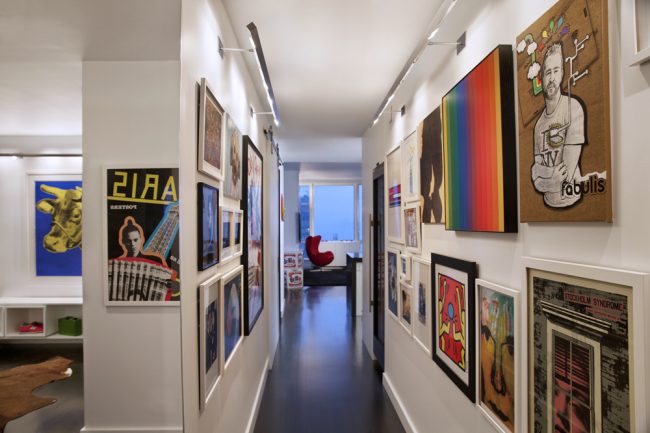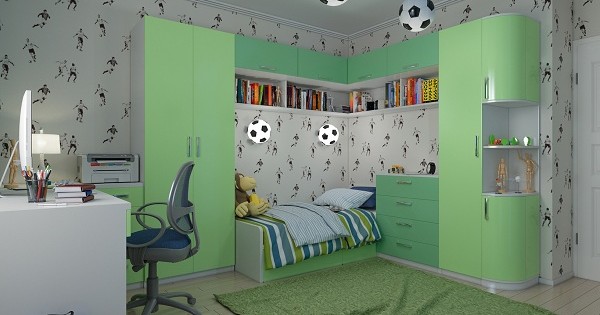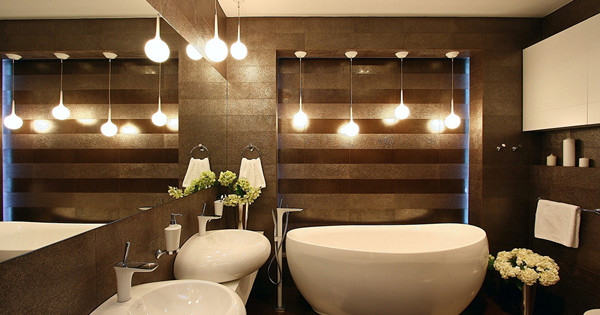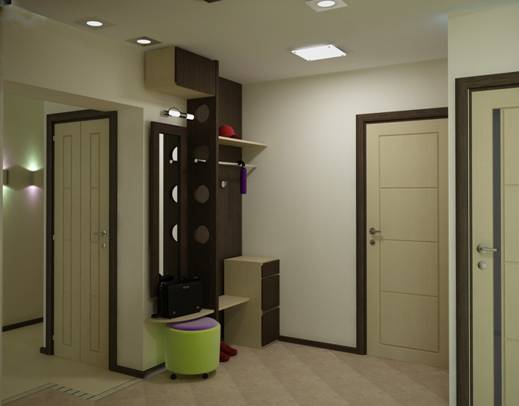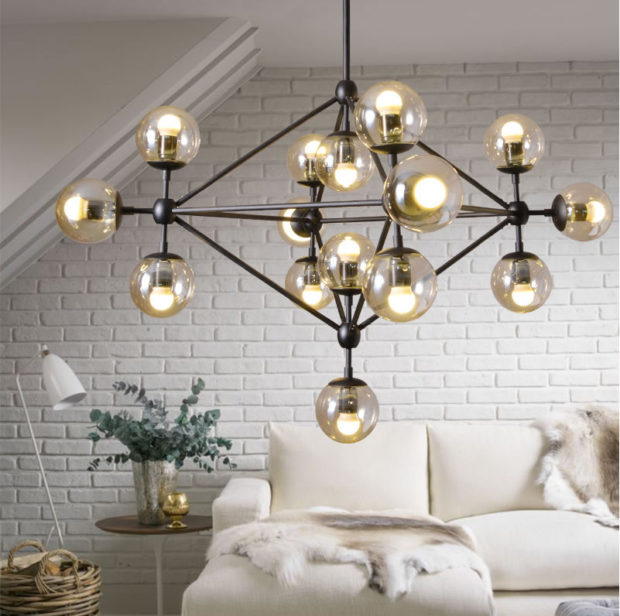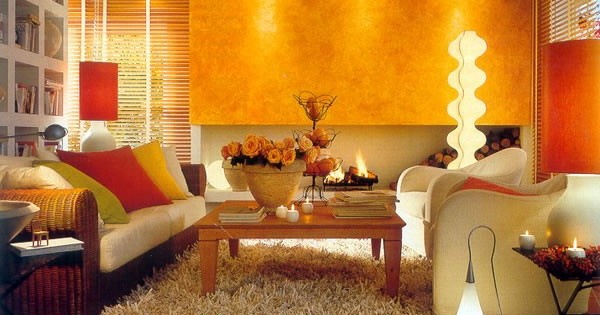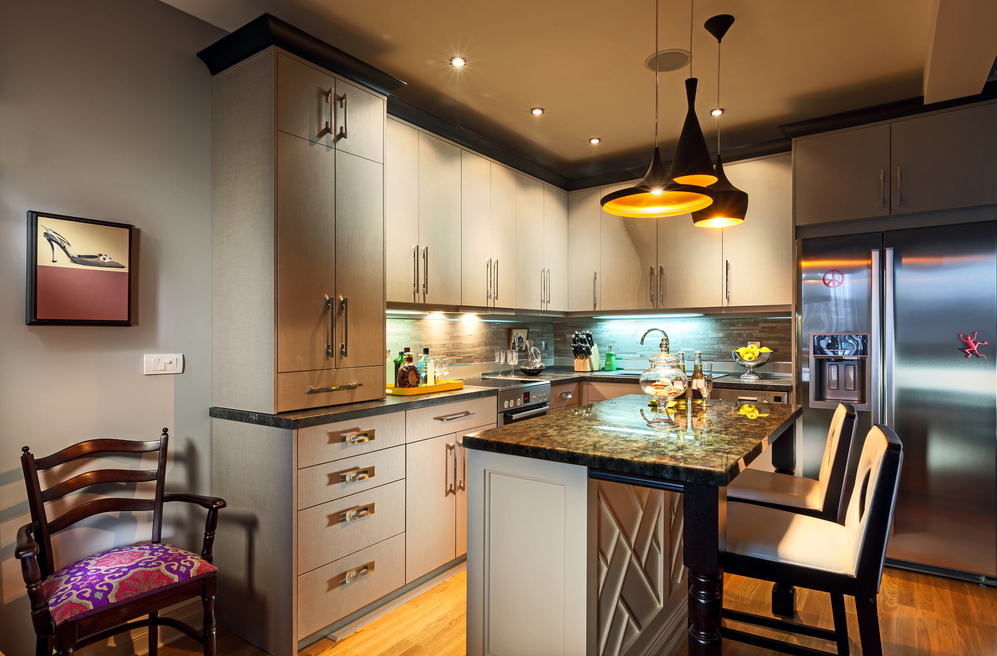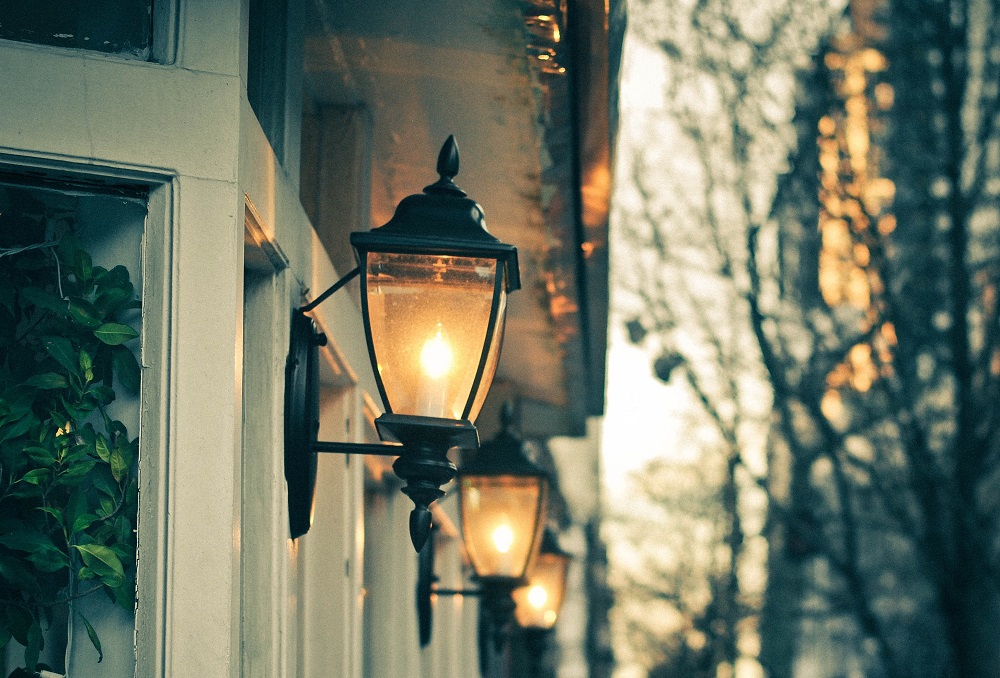7 Tips for Choosing a Ceiling Light
Spots, spotlights, pendant chandeliers, plate chandeliers - the offer of ceiling lights can drive anyone crazy. Resisting a huge assortment is not always easy, so many make a mistake and make a spontaneous, impulsive choice, focusing only on external attractiveness. Nevertheless, when choosing a ceiling lamp, it is necessary to take into account a lot of other factors, take into account the size of the product, its design, the direction of the light flux, the type and height of the room where it will be used. We get the real multifactorial dependence, but to solve this equation is not so difficult if you drop emotions and even before buying clearly determine which lamp is needed.
No. 1. The main types of ceiling lights
The main task of artificial lighting is clear even to a child. However, it is not enough for the lamp to simply give light - it is important that this light helps create a comfortable environment. It should not hit in the eyes, distort the colors of objects or impede the perception of space. Some areas require bright lighting to organize, while recreational areas require soft, diffused light. Obviously, one lamp can not cope with so many different tasks, so humanity has come up with different designs of lighting devices.
Ceiling lights can be divided into the following types:
- outboard. The most striking example is familiar to all of us. chandelier. Such lamps are attached to the main ceiling by a chain, spring or bar, and are located at some distance from it. By size pendant lights can vary greatly: luxurious crystal chandeliersfor example, successfully fit into large tall rooms. For rooms with low ceilings, pendant lights are not the best choice, but compact models can also be found. Chandeliers can create as diffused general light, and directed - it all depends on the design of the ceiling. Often a group of several pendant lights is installed over the dining table, the suspension height in some models can be adjusted. The number of lamps in such products is from 1 to tens;

- waybills. These include chandelier plates, They are often called shades. Such products are attached to the ceiling and feature a flat compact design, due to which it is good suitable for low rooms. By a variety of shapes, sizes, materials and other design features, overhead lights are not inferior to pendant;

- recessed. They can be mounted in a suspended or stretch ceiling, allow you to create an interesting lighting system, occupy a minimum of space, are installed on the same level with the ceiling, can be rotary. With growing popularity on rack and pinion, drywall ceilings and other suspended structures such lamps are used more often. Often the concepts of recessed and spotlights are confused. Spot lighting Is a system of single compact fixtures, they can be ceiling mounted or overhead and protrude slightly above its surface;


- spots or spotlights turned out when in one design the advantages of spot lighting and overhead lamps were combined. The spots give narrow directional light, have a rotary structure, are installed in several pieces on one guide. A great option if you want to enjoy the benefits of spot lighting, and a suspended or suspended ceiling for some reason cannot be done. In addition, it is worth making a minimum of effort - and the direction of the light can be changed, creating the necessary atmosphere in the room;

- separately it is necessary to highlight flexible lights. it led strip, less commonly used neon tubes and duralight cords. They take on the role of decorative lighting, are located along the contour of the ceiling and in skirting board.

The choice of the type of ceiling light depends on what kind of lighting you need to create, how high the ceilings in the room, and what technology they are made of.
No. 2. Types of luminaires by light distribution
Depending on the design and material of the lamp, it can give light of different directions. According to light distribution, lamps can be divided into the following types:
- direct distribution. This is a directional luminous flux to illuminate a specific area, such as a desk or countertop in the kitchen. Such light is given by spotlights and spots;
- mostly direct. In this case, the light falls on the illuminated surface, and only a small part of it is scattered upward, making it possible to create pleasant, uniform lighting in the rest of the room. Such light is given by lamps with lampshades made of transparent material;
- predominantly diffuse lighting It is created by the direction of the flow of light into the ceiling and the reflection of rays from it. The design of many chandeliers provides the creation of just such light;
- diffuse lighting It turns out when the light is directed to the ceiling and walls. The rays reflected from the surfaces create a pleasant and calm lighting.
Naturally, it is impossible to say how the type of light distribution is better - the choice of a particular type depends on the tasks and the need to create lighting of a certain nature.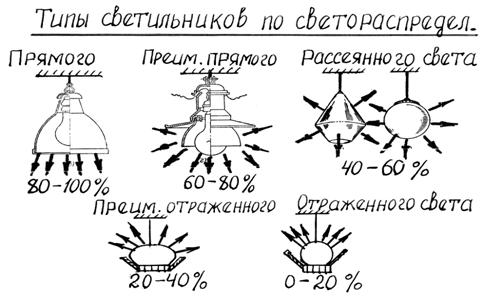
Functionality lighting is:
- the main. It is necessary to navigate in space and comfortably engage in activities that do not require strong visual concentration;
- working or zonal. It is used to illuminate places where brighter lighting is needed (for reading, working, sewing, etc.);
- decorative. It is used to highlight paintings, niches, arches, skirting boards or other elements of the interior. Can be used to create a specific atmosphere.
In one room, you may need all kinds of light, so in modern homes you must use multi-level lighting. Various types of ceiling lights are useful for this, which will be supplemented by LED strips, floor lamps, table lamps, sconces and lights in the cabinets.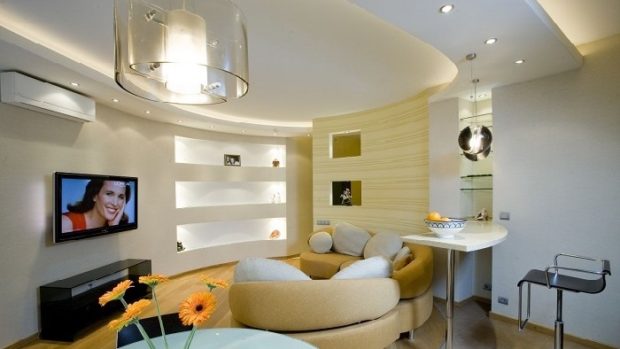
No. 3. Type of lamp for ceiling lamp
Though bulb type selection - This is a completely different topic, but we can’t ignore it, since the organization of lighting and the nuances of choosing the design of a ceiling lamp to some extent depend on which lamp will be used. There are several options today:
- incandescent lamps they are inexpensive, have a pleasant warm light, but they do not last long, are uneconomical, have low efficiency and high heat dissipation, therefore their scope of use is limited. When it comes to choosing ceiling light for stretch film ceiling, then it is better not to use incandescent lamps - they can damage the film with their heat;
- halogen lamps similar to incandescent lamps, but in them the bulb is filled with halogens, which allows you to somewhat extend the service life. With dimmers, such lamps can last up to 8 thousand hours, but you can’t call them economical anyway. In addition, their heat transfer is also high;
- fluorescent lamps 5 times more economical than incandescent lamps and 5-20 times more durable. The surface of such lamps does not heat up much, the temperature of the light can be almost any. The main disadvantage is the content of mercury vapor in the flask, therefore, they must be handled with care during operation. Problems are also associated with the disposal of such products. Among other disadvantages, sensitivity to voltage drops, flickering and the need for some time for the lamp to begin to shine at maximum;
- LED lamp - the most modern today. They are 6–10 times more economical than incandescent lamps and 2–3 times more efficient than fluorescent lamps, are durable (shine up to 20–50 thousand hours), are safe, do not require heating time, are not sensitive to power surges, and are durable and do not heat up. These are the most expensive lamps of all, but they give a guarantee for a couple of years, and they serve for years. For rooms where the lighting turns on every day for several hours, this is the best option.

Number 4. Features of the ceiling and type of lamp
Going to the store for the lamp, do not forget to take into account the features of the ceiling design:
- low ceilings and massive chandeliers are an absolutely incompatible pair. Comfortable livelihoods can be ensured if the distance from the floor to the lower edge of the lamp is 2-2.3 m. IN Khrushchev, where the ceiling, according to the project of 2.3 m, it is better to use luminaires of overhead type, spots and built-in lighting. If the ceiling height is more than 3 m, you can look towards beautiful hanging chandeliers, but do not forget to measure the size of the lamp with the area of the room - a small chandelier in a large room will look as ridiculous as an excessively large lamp in a small room;

- for concrete and wooden ceilings mortise type of lamps is not suitable. You will have to be content with different types of chandeliers, and if the ceiling height is small, then overhead lights and spots will come to the rescue;
- for false ceilings all kinds of fixtures fit. It is important only during installation of the structure to leave the necessary technological gap between the main ceiling and the pendant, and correctly cut openings for future lighting items. False ceilings give maximum scope for imagination, allow you to organize a complex lighting scheme and hide all the wires;
- stretch ceiling also allow you to create sophisticated multi-level lighting. If you choose a film ceiling, then you need to take into account that it is afraid of strong heat, so incandescent lamps for built-in and overhead lamps are a taboo. They can be used at a distance of 30-40 cm from the ceiling surface, the maximum power of incandescent lamps is 60 watts, halogen lamps is 30 watts. It is advisable that such lamps are not directed to the ceiling. For stretch ceilings, energy-saving lamps (LED and fluorescent) that emit a minimum of heat are best suited.

No. 5. How much light will the lamp give?
To create a sufficient level of lighting in the room, it is necessary to choose the correct design of the lamps, their number and lamps of the required power. For everybody type of room lighting requirements are different:
- for bedrooms and other rooms with dim light, it is necessary to provide 10-12 watts of lamp power per square meter;
- for child, a bathroom and rooms with an average level of lighting, the norm is 15-18 W / m2;
- for kitchens and other rooms where the light should be bright - 20 W / m2.
Immediately, we note that all the norms below are related to general (not working and decorative) lighting. Parameters are given for incandescent lamps. When using another type of lamp, power level conversion tables can be used.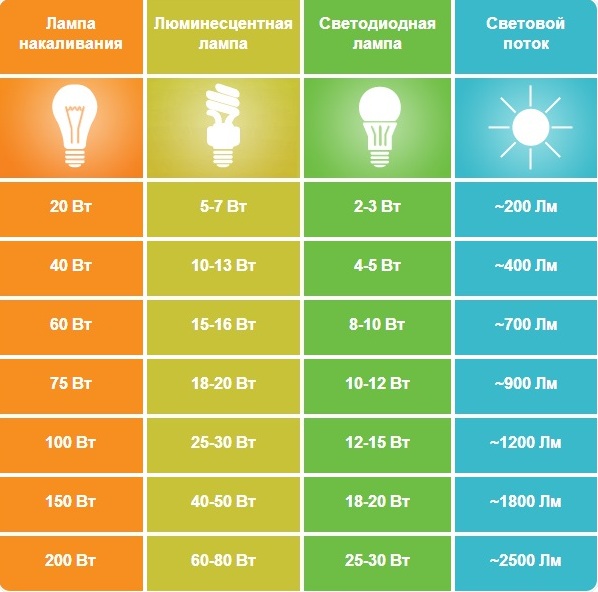
For example, for a kitchen with an area of 10 m2 It is necessary to provide 200 watts of lighting power. These are 5 incandescent lamps of 40 W each, 10 incandescent lamps of 20 W or 2 per 100 W - it all depends on the design of the lamps and their number.If LED lamps are used, then 5 lamps for 4-5 W or 3 for 10 W will be needed.
Much, of course, depends on the nuances of the design. To prevent the light from blinding, choose opaque lamps in which the ceiling completely covers the lamp.
As for spot lightingthen one lamp illuminates an area of about 2 m2. If such light will be used as the main, and not as additional, then a lot of lamps will be needed - they are installed in increments of 1-1.2 m, the distance to the wall is 0.6-0.7 m.
No. 6. Style and material
It is not possible to describe the entire range of fixtures presented in stores - literally every season, designers surprise us with new functional finds. This means that each of us gets a chance to arrange the room exactly the way we want. On the other hand, the interior should be harmonious, therefore the luminaire must fully meet the selected style premises.
Ceiling lights can be made of such materials:
- metal allows you to create both classic forged chandeliers, as well as ultramodern spots, which will become an integral element of the interior in hi-tech style or minimalism. The design can be made of different metals and alloys, have a shade from almost black to chrome. Metal is a plastic material that allows you to form a lamp of any shape. Simple recessed metal lights fit into modern interiors, unusual chrome chandeliers and spots - in style modernfancy forged - in classic interior. There are options for loft and even provence;

- wooden fixtures - this is mostly chandeliers and overhead lights. They are diverse in size and shape, will become an interior decoration in ethnic style (Japanese, country). It is better to use such lamps in dry rooms with a stable temperature regime;

- glass - a plastic material that allows you to create both elegant pendant chandeliers and compact overhead lamps. The shape, degree of transparency and color of the product may vary dramatically, but the general advantages include universality, spectacular appearance and resistance to various kinds of negative influences. To maintain the lamp in proper condition, it will only be necessary to periodically wipe it from dust;

- textile as a rule, chandelier-plates are performed, there are also hanging chandeliers with fabric shades. Textiles allow you to translate into reality any design idea and effectively scatters the light. Despite the fact that they use durable fabrics with special impregnations for the manufacture of such lamps, they do not have a place in the kitchens. A textile lamp is a good option for an interior in style classic, provence, country, boho - it all depends on the type of fabric and shape;

- plastic ceiling lights - These are hanging chandeliers and plate chandeliers. Plastic sometimes creates very unusual products, they are not afraid of moisture, easy to care for, but it’s better not to use ordinary incandescent lamps with high heat dissipation. A plastic lamp is a good option for an interior in style modern.

There are also paper fixtures, but this is an option for an amateur. If you cannot find a suitable design, you can always create a ceiling yourself.
As for design spotlights, then it does not differ in special variety and refinement, because the very essence of such designs does not imply their emphasis. Spotlights are necessary to create a bright local lighting, and for beauty it is necessary to take a chandelier.
The luminaire must match the style of the room not only in terms of the material of execution, but also in form. So, for example, Art Nouveau suggests the presence of smooth curved lines, which can be used in the lamp.The classic interior is chic crystal or wrought iron chandeliers. For hi-tech, both modest spotlights and futuristic metal and glass chandeliers are suitable.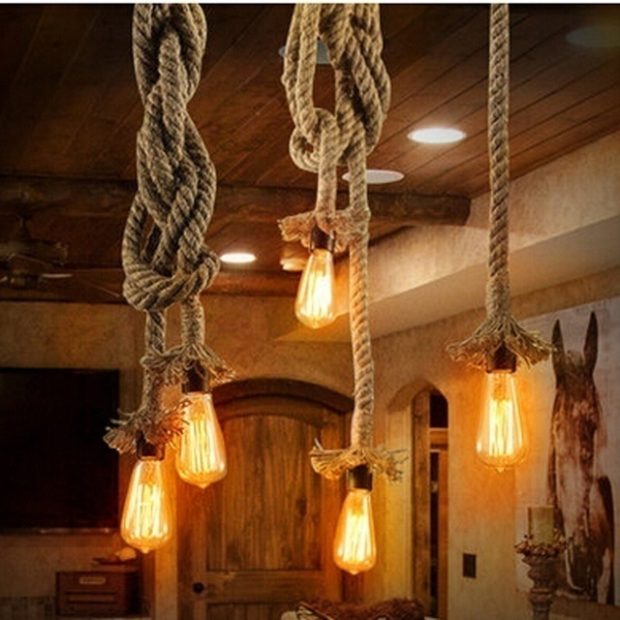
Number 7. Ceiling lamp and room type
We are not entitled to dictate the terms and impose our opinion on the lighting of different rooms, but some rules should still be followed:
- in the living room better to create multi-level lightingso that in a matter of seconds it is possible to adapt the room to perform a particular function, the presence of dimmable lamps is welcome. You can provide a central pendant or overhead chandelier, it all depends on the height of the room and the chosen style. It can be supplemented with spotlights along the contour of the room and in separate areas. If the luminaires cannot be built in, spots will do. Do not forget about LED strips, floor lamps and sconces that will make the recreation area more comfortable;

- the kitchen equip a common lamp of diffused light, separately illuminate the working area using bright directional light. Several pendant lamps can be placed above the dining table, the distance from them to the surface of the countertop is at least 60 cm. Preference is given to moisture-resistant and easy-to-care materials. For small kitchens a good solution will be spots, the light from which can be directed in different directions;

- hallway - This is often a compact room, but the light here is quite bright, because the sun's rays do not penetrate here, but to see yourself in a mirror before going out somehow it’s necessary. You can use the ceiling overhead lamp, spotlight or spot;

- in the bedroom central light should give a muffled soft light. If the room is closet, then the area around it must be additionally highlighted. It is imperative to provide lamps in the bedside zone;

- for bath select compact, moisture-resistant luminaires with high radiation intensity;

- cabinet it is better to equip with a common ceiling lamp, which gives a minimum of shadows, and a table lamp. Leave all the original lighting design ideas for other rooms - in the office the lighting should be calm, monotonous and set up for the work process.
Finally, we note that it is better to draw up a lighting scheme even at repair phaseto advance lead wiring or create the necessary holes. Proper planning will save a lot of problems and troubles.

